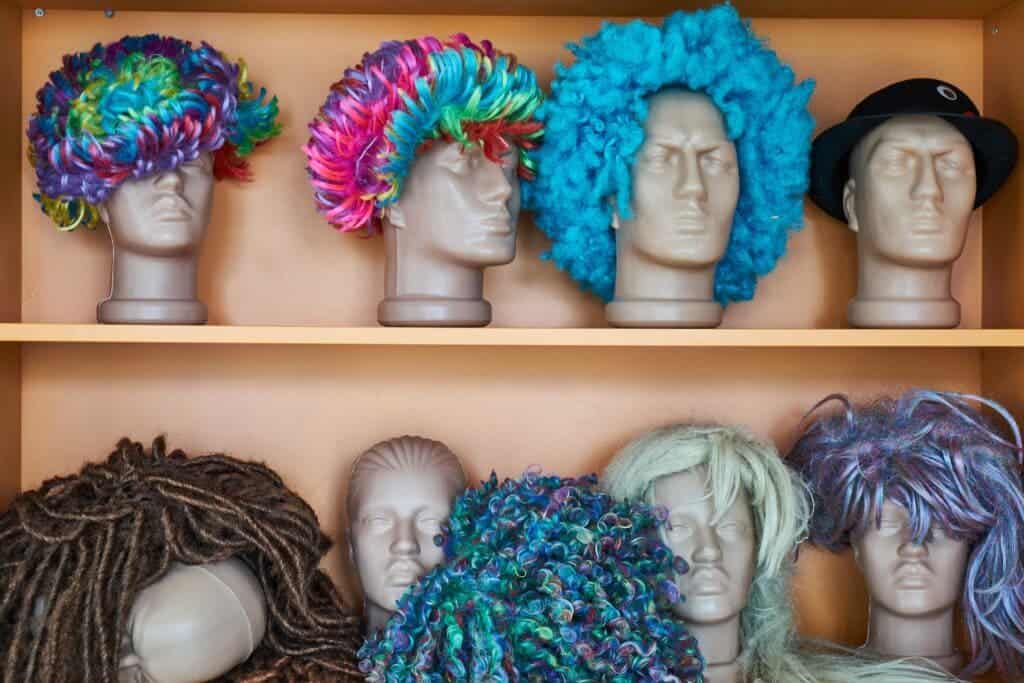Exactly why humans lost their fur is unclear, but our skinny exteriors set us apart from most of our mammalian cousins.

Still, us shedding our fur had a dramatic effect on the evolution of our species. To understand why, let’s take a look at what body hair does and see what benefits or drawbacks it brings to the table.
First off, what is it?
Each strand of hair is a filament made out of the protein keratin; when hair grows thickly across an animal’s body, we call it fur.
Hair is a hallmark of mammals, but this family doesn’t have a monopoly on hairs. Insects grow hairs too, although theirs are different in structure from our own. Bees, for example, use it to keep them warm, but also as a sensory organ and to carry pollen. Other species of insects, for example, the fruit fly Drosophila, mostly use them as sensors for tactile (touch) and olfactory (smell) input — a fly’s antennas work similarly to our noses, having a pore to allow smell in and neurons at the base of the strands to sense odors.
Some lichens, algae, plants, and a group called protists can grow trichomes, which is like plant-hair. Trichomes serve a wide range of functions including nutrition, the absorption and retention of water, as well as protection from radiation, insects, or larger herbivores.
And now, fur
Fur consists of an undercoat of finer hairs that helps trap heat, and an outer coat (the ‘guard’) that’s oily and keeps out water.

Image via Wikimedia.
The most obvious use of fur is to help you keep warm. Animals that produce their own body heat, most notably mammals, use fur as an energy-saving mechanism. A coat of hair traps air around the animal’s body, which provides insulation. Going without one is like always keeping the window open during winter — you can probably keep the place warm, but your energy bill will skyrocket. Evolution doesn’t like paying bills.
Fur protects against damage from the elements or other threats. A hairless animal on a cold winter night could avoid hypothermia but still develop frostbite (because tissues can’t transfer heat fast enough to prevent freezing). In a pinch, fur can also ward off light scratches or bruises, and some animals have water-repellent coats.
The most obvious drawback of having fur is that it costs energy and nutrients to grow. Hairs are renewed constantly to keep them healthy and efficient, and when you’re covered with them, it adds up fast. A 40kg-sheep for example can produce up to 13.6 kg (30 pounds) of wool per year and eats roughly 1.1 kgs of dry food per day (around 400kgs/year), according to SmilingTreeFarm. Its fleece weighs around 3.4% of its total annual intake of food — another way to look at it is that two weeks out of the year, this hypothetical sheep eats only to grow its fur.
Most other drawbacks of fur are dependent on context. Wet fur is a complete liability as it’s heavy and good at trapping water, which will chill you thoroughly. Dry fur is a good insulator but can also make you overheat in hot climates (most mammals apart from primates don’t sweat). Fur is a great home for parasites and creepy crawlies. Shed hairs can create a scent trail for predators to follow — even human hunters look for hairs in the brush when stalking prey.
Of course, fur can also help you stay hidden if its color is just right.
Hair
The hair on our heads still acts as insulation and offers some degree of protection against solar radiation. A testament to its usefulness is that the follicles on our scalps (these are the ‘foundations’ from which hairs grow) have longer active growth periods than any other on our body. The strands of hair on our head can keep growing for years, whereas most others grow for weeks or a few months.

But not all hair grows to keep us warm. Our eyebrows are designed to keep sweat from our eyes, and are thus a product of our lack of fur. We have hair inside our noses, meant to keep out dust and other particles. There are strands of hair inside our ears that allow us to keep balance.
Hair is also meant to help us mate and signal various information to the group. Facial hair for men as well as body and pubic hair for both sexes show maturity. Guys tend to be the hairier of the sexes, and this is a product of testosterone. The most common theory as to why is that it helped keep ancient men warm on those long cold nights out hunting mammoths. But that wouldn’t explain why both sexes have a thin, almost invisible coat of body hair; from experience, I can also vouch that a hairy forearm won’t do much good in winter.
One proposed alternative is that it’s meant to help us feel parasites, and that women tended to favor men who had fewer parasites on them (sounds reasonable). This would have generated an evolutionary pressure for hairier men, as women essentially selected for this trait.
Male pattern baldness, also a product of testosterone, could help signal dominance in the group. Males in other species also signal their position in the group through hair, such as dominant silverback gorillas (whose back hairs grow gray) or black-maned lions.
Finally, many species employ hairs as sensory organs. Whiskers are a prime example. They’re academically known as ‘vibrissae’ and come in two forms: the longer, thicker ‘macrovibirssae’ (that animals can typically move voluntarily) and the smaller, thinner ‘microvibrissae’ (which are typically immobile). Whiskers grow in groups on various parts of an animal’s body, most commonly on their snouts, and are used to sweep a wider area using touch. They vibrate when coming in contact with something, and blood vessels at their roots amplify this vibration for the animal to perceive.
If you’re a cat sticking your head in a dark mouse’s hole, having a good set of whiskers can help you find your meal. Spiders are another great example of hair used as sensing organs. They wear their bones (a chitinous exoskeleton) on their outside. Hairs grow out of this skeleton and help transmit vibrations from the soil or web to the animal, acting similarly to hearing or a long-range sense of touch. Note that while mammals grow their fur from keratin, insects use chitin.
So why don’t we have fur?

Image via Reddit.
You might be surprised to hear that humans and other primates have virtually the same density of hair follicles (and thus, hairs) over most of their body. The difference is that ours is ‘vellus hair‘, so short and fine that it’s almost invisible. So it’s not that we lost our body hair, we just changed its type.
We don’t really know why this happened. We have several theories, though.
One of them is that, as our ancestors moved down from the trees, they also discovered seafood. Since wet fur isn’t effective, this could have favored individuals with less fur. However, this isn’t regarded as the likely reason, or at least not the main one.
A more widely-accepted theory is that our ancestors needed to better control their temperature as they switched from living in forests to living in the savannah. No fur meant they could sweat more, preventing heat exhaustion. This may have directly underpinned the success of our species by allowing us to outlast, and thus capture, prey.
Our largest departure from the primate family in regards to our skin comes from our sweat glands. Humans have up to ten times as many eccrine (sweat) glands than chimps or macaques. We also have extremely few apocrine glands, which produce an oil-like substance. Our primate cousins can have equal parts eccrine and apocrine glands and other animals such as dogs will only have apocrine glands on their body and eccrine ones on the pads of their feet or other hairless areas.
The truth is probably somewhere in the middle, and our hairlessness was caused by several factors working together. Environmental pressures and a selective advantage during hunts started the process, and human ingenuity (which means fires and clothes to keep warm) kept it going up to today. However, the heavy presence of sweat glands on our skin suggests that thermoregulation (keeping our bodies’ heat just right) was a major advantage of our hairless outsides.
When?
Keep in mind that there are still many unknowns regarding our hairlessness. But two moments in our evolutionary history could have started this transition.
The first was in our very ancient past, as our furry ancestors climbed down from the trees. Humans have never been too physically imposing, and our ancestors were probably similar in this regard. The theory goes that they focused their activity during the hottest parts of the day in order to avoid predators (who would be hiding from the sun and avoiding activity), which made it advantageous to sweat and made fur impractical. This likely took place around four to seven million years ago. Essentially, in this scenario, it was our efforts to avoid being eaten that lost us our fur.
The second possibility is that humanity needed to shed the hairs in order to be able to hunt. Again, our bodies are very tiny and fragile compared to most wildlife. We’re slower than most animals we’d like to hunt, have no fangs, no claws, and can’t roar. We had tools, maybe spears, to help, but they couldn’t make up all the difference.
However, what our ancestors (and call center operators) can tell you is that you can accomplish a lot if you just tire your competition out. Persistence hunting was one of the few ways our ancestors could acquire large quantities of meat apart from maybe scavenging (which is dangerous and not very lucrative).
Despite our many shortcomings, humans are the best persistence hunters on the planet (or at least among the top ones) simply because we can sweat and cool down even while running. Our ancestors figured out that they didn’t need to fight and stab the antelope; they could just scare it away and chase it, tire it out so that it couldn’t fight back. And then stab it — safely.
This scenario would be more recent — around two million years ago — as hominins like Homo erectus (the first bipedal hominin) started hunting. Bones with tool marks discovered at Homo erectus sites show that they were hunting and butchering large prey regularly. Their bone structures suggest they could walk and run much better than earlier hominins due to longer legs, a foot structure more adapted to walking upright, and larger butt muscles. In this scenario, it was our efforts to catch and eat other animals that cost us our furs.
We may never know for sure why our skin is pink and bare when all our relatives are furry. Personally, I find “because it helped our ancestors survive, somehow” to be a satisfying answer. What I do find more interesting to ponder, however, was whether the way our ancestors wanted to live made fur obsolete, or whether they lost their coats first and then just tried to make the most of it.
Wherever the answers may lie, I’m pretty happy to be a skinny ape; especially as I pick clumps of my cat’s fur from the floor.


